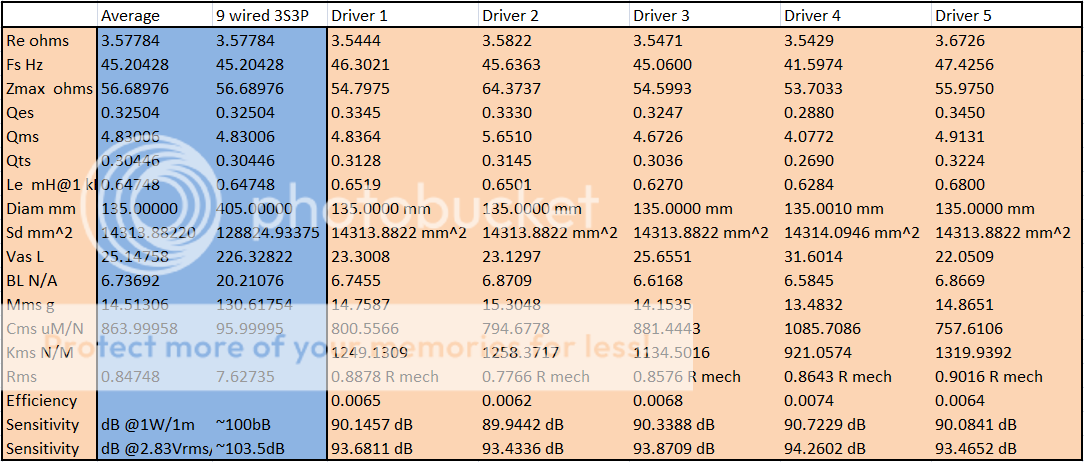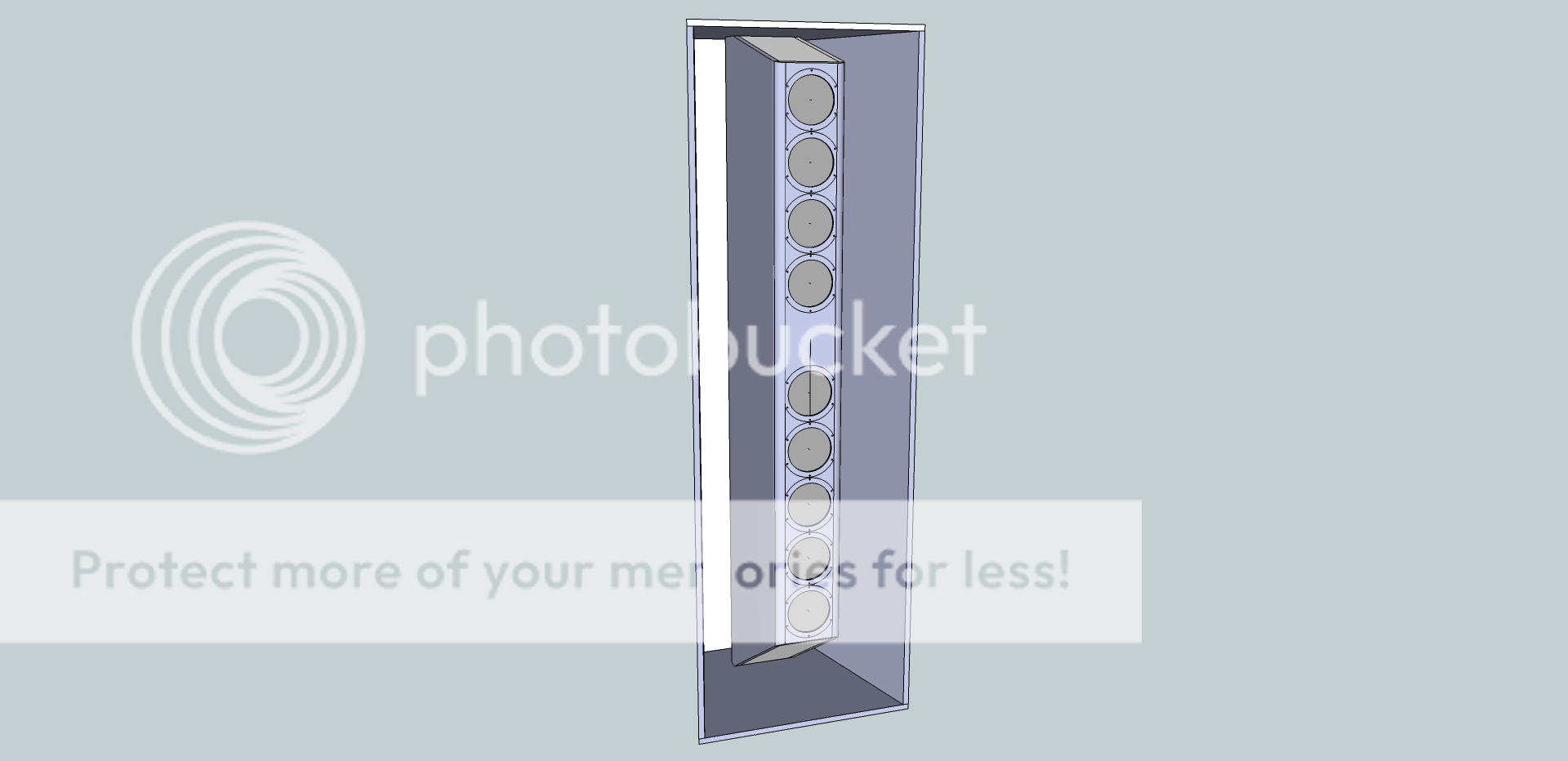Oh. I dunno if that's good or not, the internal length is 81.25", it is shown without the back panel, so it's "closed" I guess. The ports are 3.5" x 12.5 x .75" hwl tuning is @ 70hz.
I've no prior experience with TL's, so this sounds like the proverbial can of worms to me. Any recommendations?
I've no prior experience with TL's, so this sounds like the proverbial can of worms to me. Any recommendations?
I didn't see any ports in the box... the holes in the top and bottom, are going to completely screw up your porting.
Even without the holes on the ends, the ports & the high aspect ration are going to make the box a mass-loaded transmission line (ML-TL) not a bass reflex. Your BR model is only valid for cabinet dimensions that don't stray far from a cube.
dave
Even without the holes on the ends, the ports & the high aspect ration are going to make the box a mass-loaded transmission line (ML-TL) not a bass reflex. Your BR model is only valid for cabinet dimensions that don't stray far from a cube.
dave
I think the holes at the top and bottom are (supposed to be) the ports.I didn't see any ports in the box... the holes in the top and bottom, are going to completely screw up your porting.
Agreed it will behave more like a transmission line than a bass reflex, but as it's driven more or less uniformly along it's length, the standing waves shouldn't be too bad - certainly much better than with a single driver part-way down.
Could be good but not easy to model. I seem to remember that this sort of thing is easier to model i.t.o. transient response rather than frequency response (with home-brew spreadsheets anyway). I'm not sure what fancy software is available nowadays, but if HornResp can cope with multiple drivers, it might be ideal for this. (Horn-modeling software tends to be good for transmission lines and reflex boxes too).
Alternatively, to make it behave like a reflex box, you could have separate ports next to each driver and pretend it's a lot of little BR boxes stacked on top of each other.
btw, Is the large rectangular cut-out 1/2 way down the front for a tweeter? (presumably it's not another port)
Cheers - Godfrey
The holes are the ports .75" being the thickness of the MDF, the internal volume is ~100l.
*******
This is getting very interesting... I thought you couldn't really effectively drive a TL with an array of drivers like this?
I took a look around and I see your SD12 TL is similar in internal height and a bit wider than my proposed test mule.
I should have my drivers tomorrow but I've averaged a couple sets of measurements of this driver I've found on the web. The driver is the 299-250 closeout at PE.
The intended use is as an HT main to be HPF'd @ 80hz with the Econowave JBL horn and a BMS like driver, the JBL 2408h. If I could have an extended response for use without the HPF that would be great provided it does not compromise the sound for extension.
What would you do if you had an array of drivers that summed as a single driver with these parameters?

I HAD a starting point like this:
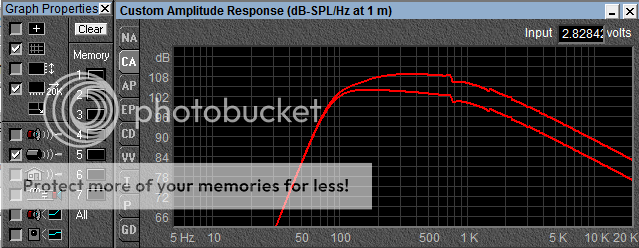
with and without baffle step
External dimensions 15" wide x 90" tall 1.25" roundovers
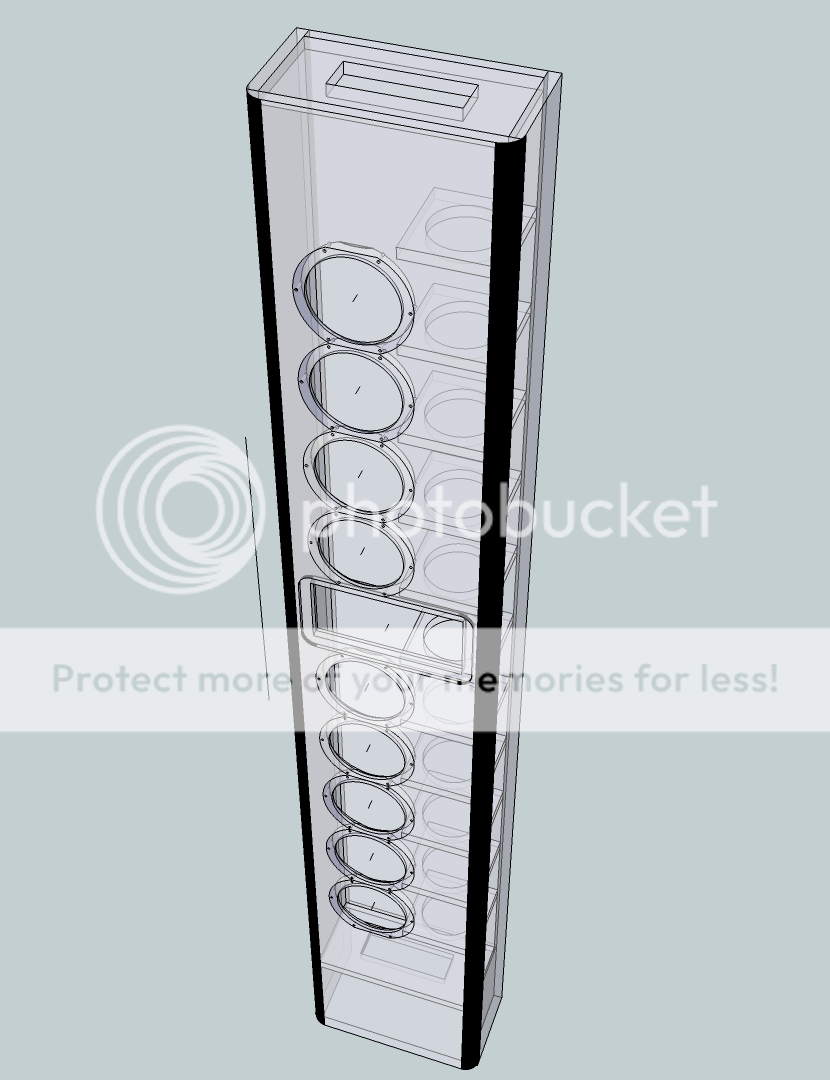
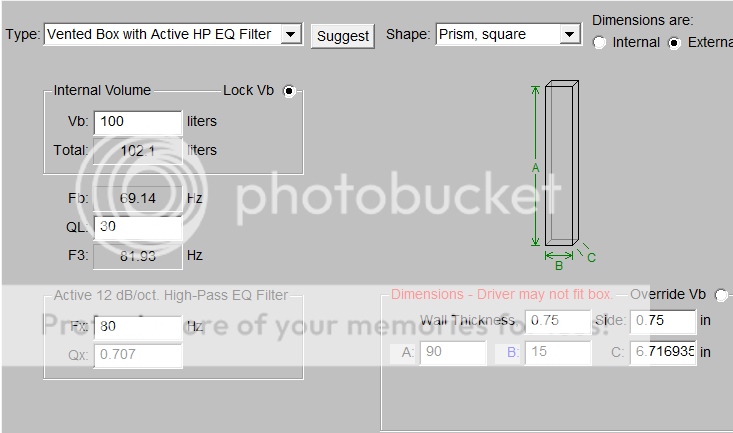
*******
This is getting very interesting... I thought you couldn't really effectively drive a TL with an array of drivers like this?
I took a look around and I see your SD12 TL is similar in internal height and a bit wider than my proposed test mule.
I should have my drivers tomorrow but I've averaged a couple sets of measurements of this driver I've found on the web. The driver is the 299-250 closeout at PE.
The intended use is as an HT main to be HPF'd @ 80hz with the Econowave JBL horn and a BMS like driver, the JBL 2408h. If I could have an extended response for use without the HPF that would be great provided it does not compromise the sound for extension.
What would you do if you had an array of drivers that summed as a single driver with these parameters?

I HAD a starting point like this:

with and without baffle step
External dimensions 15" wide x 90" tall 1.25" roundovers


No this won't be a very effective TL in the traditional sense. But loysa gotchas when it comes to trying to figure out what it is gonna do...
1/ it is a half-wave TL (and as such a nominal ~80 Hz line)
2/ substantially driven thruout its entire length
3/ terminus is a significant portion of the cross-section (and short) so not much mass loading
4/ cross-section is small for a TL
If Martin's Sheets actually do multiple drivers now, it could be modeled there, but not in anything simplistic.
Worst case, you can stuff it until it is aperiodic.
Also note that a single vertical brace (driver placement isn't optimal for it to double as a driver brace) would be more effective than the sillion little stubs you have)
dave
1/ it is a half-wave TL (and as such a nominal ~80 Hz line)
2/ substantially driven thruout its entire length
3/ terminus is a significant portion of the cross-section (and short) so not much mass loading
4/ cross-section is small for a TL
If Martin's Sheets actually do multiple drivers now, it could be modeled there, but not in anything simplistic.
Worst case, you can stuff it until it is aperiodic.
Also note that a single vertical brace (driver placement isn't optimal for it to double as a driver brace) would be more effective than the sillion little stubs you have)
dave
Maybe some sort of rear horn loading to fill in the bottom end?What would you do if you had an array of drivers ...
Perhaps something like the pic below. It would be better (but horribly difficult) to do the horn flare horizontally.
Or a sealed box somewhere between 80L to 240L and separate subs.
I suspect reflex loading tuned high won't sound too good due to lousy transient response.
Attachments
Last edited:
The ports on the ends will be worse than useless.
The dividers / braces will prevent any overall resonant behaviour of the enclosure.
Either seal it, or put multiple ports along one of the long panels - at least one port per two drivers.
This sort of enclosure is a good candidate for modeling in Akabak.
The dividers / braces will prevent any overall resonant behaviour of the enclosure.
Either seal it, or put multiple ports along one of the long panels - at least one port per two drivers.
This sort of enclosure is a good candidate for modeling in Akabak.
What would you do if you had an array of drivers that summed as a single driver with these parameters?
Can i use 10 drivers? 2 on the front, MTM, and 4 on each side push-push, XOed at about the baffle step, for a 3-way system.
A line array XOed to a single tweeter has serious issues with changing radiation patterns.
dave
Can i use 10 drivers? 2 on the front, MTM, and 4 on each side push-push, XOed at about the baffle step, for a 3-way system.
A line array XOed to a single tweeter has serious issues with changing radiation patterns.
dave
Thanks Dave but I really want to try the line array bass with a CD point source top end.
The second part of your reply, is that a reference to the point of transition from near to far field?
I've had a thought about the short ports and my application....
I'm now looking at ~150 L and 2-6"x6" ports.
Is this the more desired layout MLTL style?
Modeled as a BR the tuning is ~43hz / 32hz with one port blocked.
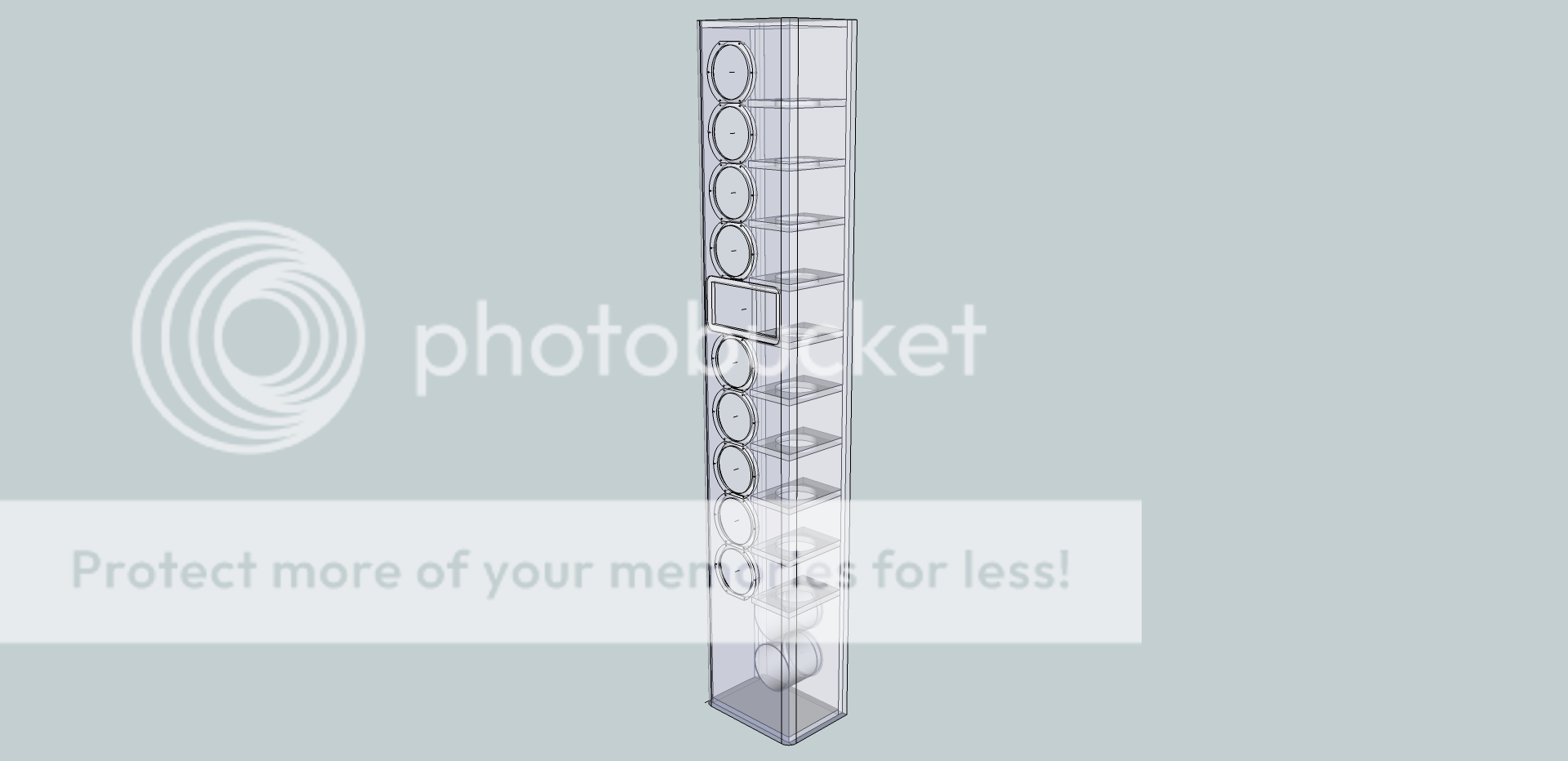
The second part of your reply, is that a reference to the point of transition from near to far field?
No, at the cross-over the speaker will transition from a line array to a point source, Change the distance you listen from and the relative levels will change. The bigger the room the worse it will be.
As ported now you have an ML-TL with a very fuzzy Zd.
dave
No, at the cross-over the speaker will transition from a line array to a point source, Change the distance you listen from and the relative levels will change. The bigger the room the worse it will be.
As ported now you have an ML-TL with a very fuzzy Zd.
dave
Understood. I will have to make adjustments for any real change in distance.
I've read the the wide radiation pattern of the WG will help somewhat. Well, that it's better than a direct radiator in that respect. By bigger you mean that I'll get less help from the room that would balance the "power response?"?
Is it the relatvely "open" area of the port problematic? Would a better solution be 4-4" ports? I can do that.
Thanks for the feedback
By bigger you mean that I'll get less help from the room that would balance the "power response?"?
yes.
Is it the relatvely "open" area of the port problematic? Would a better solution be 4-4" ports?
I don't think so. You may want to make sure that at 1st you make it so that their length can be adjusted, maybe even make them stick out. As it is a strange TL, tuning will not be as modeled with the BR software.
dave
yes.
I don't think so. You may want to make sure that at 1st you make it so that their length can be adjusted, maybe even make them stick out. As it is a strange TL, tuning will not be as modeled with the BR software.
dave
What is Zd?
I was thinking of putting in 6 ports in the test mule and plugging them to select a tuning.
What is Zd?
The distance from the closed end of the line to the centre of the driver in a TL.
dave
I myself, am not a fan of line arrays, although they 'work' for some.
i think the best solution would be not to use so many drivers for mids/bass, as Dave and other mention--btw i like the MTM and 4 drivers per side PP idea
say MTM in its own volume-closed box, and other 8 drivers PP in their own volume, located toward the bottom of the box and vented thru the top, loaded as a TL
With this line array type of design, and without straying from the design much(as i assume you dont want to) i concur that maybe the best idea would be to stuff the whole box, quite heavily, and tune it aperiodically instead. integration with a sub should in this case be fairly good
IF you decide to model the drivers as a TL, as per the suggestion Dave(and i concurred with and expanded on) made to the design with MTM and the other drivers PP, then this spreadsheet should be handy:
http://www.quarter-wave.com/TLs/Alignment_Tables_Calculator_3_3_09.xls
once again though, this will only work RELIABLY if the drivers you are loading are ALL close to the same end of the box, as the design stands its nearly as useless to model as a TL as it is to model as a BR
i think the best solution would be not to use so many drivers for mids/bass, as Dave and other mention--btw i like the MTM and 4 drivers per side PP idea
say MTM in its own volume-closed box, and other 8 drivers PP in their own volume, located toward the bottom of the box and vented thru the top, loaded as a TL
With this line array type of design, and without straying from the design much(as i assume you dont want to) i concur that maybe the best idea would be to stuff the whole box, quite heavily, and tune it aperiodically instead. integration with a sub should in this case be fairly good
IF you decide to model the drivers as a TL, as per the suggestion Dave(and i concurred with and expanded on) made to the design with MTM and the other drivers PP, then this spreadsheet should be handy:
http://www.quarter-wave.com/TLs/Alignment_Tables_Calculator_3_3_09.xls
once again though, this will only work RELIABLY if the drivers you are loading are ALL close to the same end of the box, as the design stands its nearly as useless to model as a TL as it is to model as a BR
Last edited:
- Status
- This old topic is closed. If you want to reopen this topic, contact a moderator using the "Report Post" button.
- Home
- Loudspeakers
- Multi-Way
- Possible standing wave question : )



